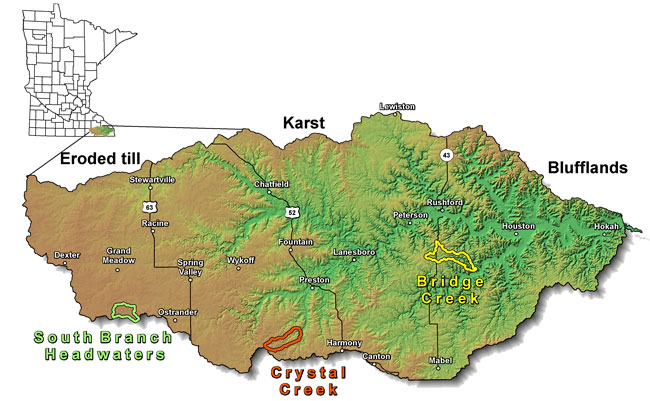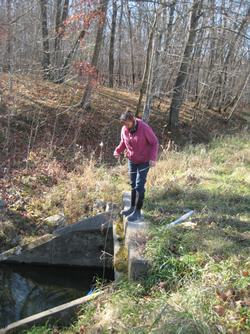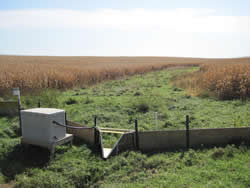The Root River Field to Stream Partnership (RRFSP) is a unique water monitoring project located in southeast Minnesota. This partnership combines rigorous data collection, strong personal relationships, and real conservation action. These key components are highlighted in an article in Issue Fifteen of the Open Rivers Journal (November 2019).
The RRFSP project uses both edge-of-field and in-stream monitoring to characterize water quality in three study areas within the Root River watershed. Through outreach activities and one-on-one meetings the results are discussed with farmers, landowners, fertilizer dealers, water managers and community leaders to promote an advanced level of conservation planning and delivery.
The lessons learned from the first seven years of monitoring and the stories of three farmers are shared in the following video released in 2018.
The purpose of this project is to conduct intensive surface and groundwater monitoring at multiple scales in order to provide an assessment of the amount and sources of nutrients and sediment delivered to the watershed outlet and also to determine the effectiveness of agricultural conservation practices.
- Phase I: Baseline monitoring was conducted from 2010-2015
- Phase II: Starting in 2016 farmers were offered a unique field walk-over opportunity to help locate the high risk areas of their land. Best Management Practices (BMPs) are now being implemented throughout the study area to address these high priority areas. Monitoring will continue for the next several years to detect water quality changes over time.
Sediment and nutrient losses peak at varying times of the year. Understanding these risk periods is key to reducing loss. View the documents under "Forms + Resources" or visit the Root River Field to Stream Partnership Results for more information. Documents include monitoring results and lessons learned, as well as results from the accelerated adoption of targeted conservation practices during Phase II.
BMPs & Conservation Practices Added in the Study Watersheds (updated February 2024)
-
New and restored grassed waterways: Within just two years (2017-2018), over 100,000 linear feet were installed or restored in targeted, high priority areas. For reference, typically 20,000 feet of grassed waterways are installed annually through a county Soil and Water Conservation District (SWCD) office in southeast Minnesota. About 25% of these new waterways were completed without public cost-share assistance.
-
Fifteen new water and sediment control basins and catchment ponds were installed in targeted locations. Typically, the range is 1-4 per year through a county SWCD office in southeast Minnesota.
-
Rehabilitation of a 1950’s era flood control structure, which is estimated to store on average 170 tons of soil, 1,380 pounds of nitrogen, and 350 pounds of phosphorus annually. This project has extended the trapping benefits for an additional 30-50 years. Over 20,000 cubic feet of soil was removed.
-
Over 350 acres of cover crops have been planted by farmers in the project watersheds.
-
Over 100 acres of conservation reserve program (CRP) pollinator habitat (CP42) were seeded on the highest runoff risk fields. Many of these plantings included native prairie plants for pollinator habitat as well as other rare and declining habitats.
-
100% of the buffer law setbacks are in place across all three study watersheds
-
10 acres of perennial vegetation were targeted along a private drainage ditch system in the headwaters of the Root River to reduce impacts from flooding and field erosion.
-
Feedlot improvements include an increase in manure storage to eliminate manure applications on frozen soil for two high priority feedlots, installation of three milk house wastewater treatment systems, and abandonment of two feedlots in high runoff risk locations.
-
New CRP prairie strips were installed on 51 acres in the headwaters of the Root River and Upper Iowa Watersheds. An additional 30 acres are planned for 2023. This is a collaborative effort by RRFSP and Mower Soil and Water Conservation District. Reductions in water runoff, sediment, and attached nutrients were found as a result of a 60 feet wide, 2.6 acre field border prairie strip installed in Mower County. Watch the "What are Prairie Strips?" video to learn more. This project is highlighted in the February 16, 2024 issue of the Root River Current, "Prairie Strips: Small Investment, Big Benefits".
-
About 70% of the highest priority conservation practices were addressed by the end of 2022, about 50% were addressed by the end of 2017.
-
$1.8 million in state and federal conservation funds were distributed across three watersheds over a 5-year period (60% on vegetative and structural practices, 40% on feedlot & manure waste improvements)
-
In the glacial till headwaters watershed, 64% of the High-Risk Area has been treated (after 2021), prior to 2018 only 8% of the High-Risk Area had been treated.
-
Efforts are underway to make precision conservation planning tools more readily accessible to landowners, farmers, and resource managers.
Location
The Root River Watershed is located in southeastern Minnesota. It is approximately 1 million acres in size and encompasses diverse landscape features. At least one edge-of-field and one in-stream monitoring station is located in each of the three distinct geologic landscapes of the Root River watershed.
- Western portion (Eroded Till): flat agricultural land, gently sloping glacial till
- Middle portion (Karst): characterized by karst geology: distinct features include this soil over fractured limestone bedrock, sinkholes and underground caves
- Eastern portion (Bluffland): landscape transitions into bluffs along the Mississippi River Valley

In-Stream Monitoring
 Out of over 60 sub-watersheds in the Root River Watershed, three were selected for this study.
Out of over 60 sub-watersheds in the Root River Watershed, three were selected for this study.The three subwatersheds are South Branch of the Root River Headwaters, Crystal Creek, and Bridge Creek.
In-stream monitoring sites are located at each of these subwatershed outlets. Each site captures water from an area of 2,800-4,700 acres. In-stream sites are equipped to continuously monitor stream flow, turbidity and precipitation during ice-free periods.
Approximately 35 samples are collected annually from each subwatershed outlet site. Samples are analyzed for:
- Total suspended solids
- Total phosphorous
- Dissolved orthophosphorus
- Nitrate and nitrite-nitrogen
- Total Kjeldahl nitrogen
- Ammonia
- Chloride
- Pesticides
Samples are collected by staff from Fillmore and Mower County Soil and Water Conservation Districts.
In-stream samples are used to establish baseline data and determine the long-term (more than 10 years) effects of land management activities employed as part of the project.
Edge-of-Field Monitoring
 Edge-of-field sites provide information about the amount of soil and nutrients moving off a given field into an adjacent waterway. In addition to measuring surface water runoff, equipment has been installed at one station to also measure sub-surface tile drainage. Each site captures water from an area of between 18 and 96 acres.
Edge-of-field sites provide information about the amount of soil and nutrients moving off a given field into an adjacent waterway. In addition to measuring surface water runoff, equipment has been installed at one station to also measure sub-surface tile drainage. Each site captures water from an area of between 18 and 96 acres.
Four edge-of-field sites have been installed. The monitoring equipment is located at the edge of actual working farms. Each site is fully automated to collect water samples whenever runoff occurs as well as to continuously collect data on soil temperature and moisture, precipitation and ambient weather conditions. Water samples are analyzed for nitrogen, phosphorus and sediment. In addition, water moving through the soil and below the root zone of growing crops is monitored for nitrate-nitrogen using lysimeters. Monitoring occurs 365 days per year.
- Field 1: Headwaters Watershed. Con and soybean rotation with sub-surface tile drainage (no manure), 2% slopes. Both surface and sub-surface runoff is monitored at this field.
- Field 2: Crystal Creek Watershed. Continuous corn with alfalfa rotated every 4-5 years. Liquid injected dairy manure, 8% slopes.
- Field 3: Crystal Creek Watershed. Contour strip cropping with two-thirds corn and soybeans and one-third alfalfa. Injected liquid hog manure applied to soybean acres, 6% slopes.
- Field 4: Bridge Creek Watershed. Continuous corn silage with injected liquid dairy manure (no commercial fertilizers), 6% slopes
Additional Research Activities
In addition to water monitoring, the Root River Field to Stream Partnership is also using eight complementary research tools:
- On-farm nitrogen rate comparisons
- Springshed mapping using sinkhole dye tracing and intensive nitrate-nitrogen sampling of natural springs and tributaries
- Water tracing in the Bridge Creek Watershed
- Water tracing in the Crystal Creek Watershed- conference poster (PDF)
- Digital Terrain Analysis to identify areas of the landscape where conservation practices may have the largest environmental benefit
- Assessment of stream channel characteristics
- Sediment fingerprinting to track sources of watershed sediment, a sediment budget for the Root River.
Together these tools and techniques help to characterize water quality and hydrology and represent a comprehensive scientific approach to understanding an entire watershed.
Pesticide Monitoring
In 2012 the MDA added pesticide water quality monitoring to the RRFSP stream outlet sites with a goal to better characterize pesticide fate and transport in southeastern Minnesota agricultural watersheds and better understand the conditions that can potentially lead to a pesticide water quality standard exceedance. The three RRFSP watersheds had 11 different pesticides or pesticide degradates detected out of up to 51 pesticides analyzed from 2012 through 2019. View the final report listed below. The report is located in the Minnesota Water Research Digital Library.
Partners
The Root River Field to Stream Partnership is funded by the Minnesota Clean Water Land and Legacy Amendment.

